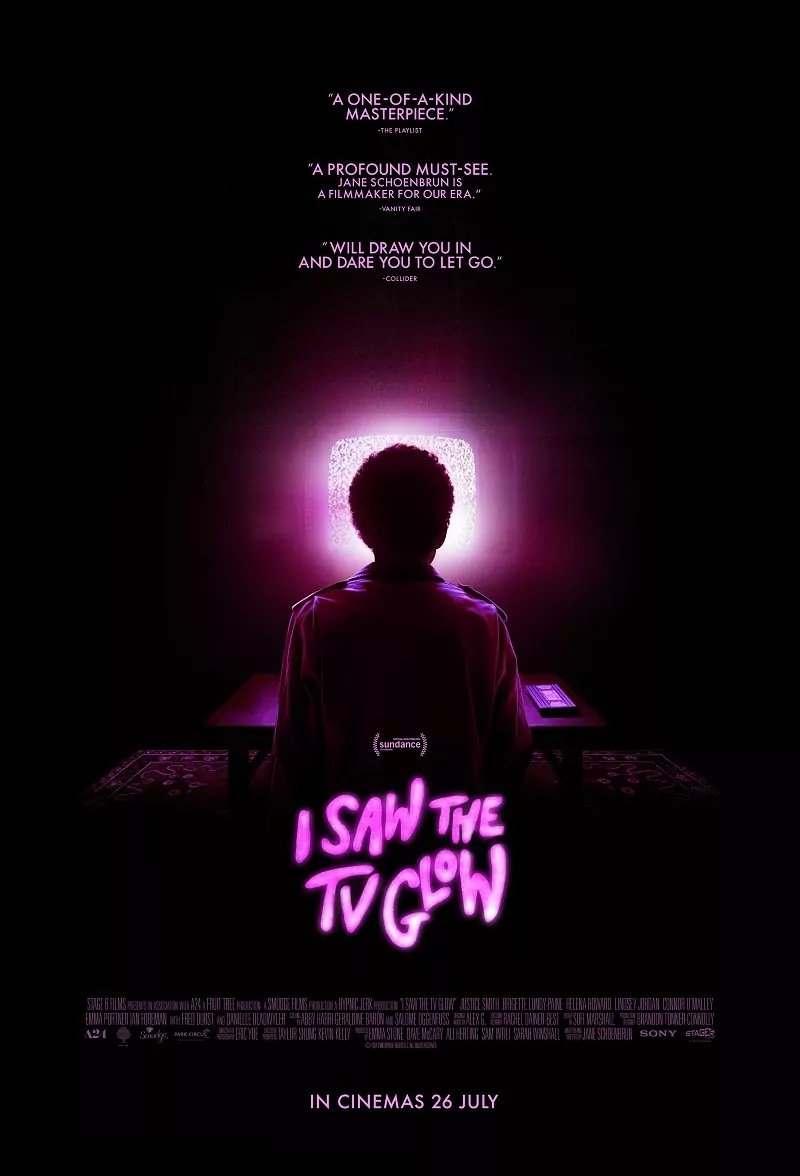Jane Schoenbrun's I SAW THE TV GLOW (Film Review)
On one level, I Saw the TV Glow by filmmaker Jane Schoenbrun and A24 is a story of two teenagers, named Owen and Maddy, on the outs. They both come from troubled homes. They’re awkward kids, friendless aside from a burgeoning connection with each other, which is prematurely cut off when high-school-age Maddy decides to run away. She leaves without a word to anyone but Owen, but he can’t muster the courage to join her, and as the rest of the movie unfolds, taking us through decades of Owen’s life, we see the toll this takes — Owen is heartbreakingly alone.
But the film is also a complex work of art that plays fast and loose with the rules of realism to offer a vision of what’s possible beyond the world as we currently know it. Maddy and Owen bond over a shared love of a TV show in the mode of Buffy The Vampire Slayer, called The Pink Opaque. The show features two main characters fighting monsters, chief among them the archenemy Mr. Melancholy, a baddie with the face of the Man in the Moon, whose evil plan is to cut out the hearts of a hundred lonely kids. It’s little wonder the plot speaks to Maddy and Owen, who are further distanced from their suburban 90’s surrounds by their queerness, Maddy unwavering in her knowledge that she likes girls; Owen still trying to figure it all out, although both the film and Schoenbrun suggest that Owen doesn’t feel right being gendered as a boy. (I’ll be using they/them pronouns for Owen through the rest of the review.)
A more conventional film would have stayed grounded in straight psychological realism, taking the viewer into Maddy and Owen’s world and the role The Pink Opaque plays in it. But worlds are permeable in I Saw the TV Glow; the fictional universe of The Pink Opaque doesn’t stay put on the screen. At first this is just a pink shimmer that sparkles at the edges of some of the scenes in Maddy and Owen’s real world. As the movie progresses, however, this seepage becomes more central, begging the question of what it all means.
Case in point: Maddy doesn’t stay missing. She reappears, ten years later, almost out of nowhere, to seek Owen out. She has a wild tale about where she’s been all this time — in The Pink Opaque. Battling Mr. Melancholy, inside a realm she was only able to access by paying some creep of a coworker to bury her alive. She’s back because she needs Owen’s help; she can’t defeat Mr. Melancholy alone.
Is she crazy? Owen decides she is — how else to make sense of her story? — and runs from the grave-portal she’s dug for the both of them.
And then spends the rest of the movie in increasing isolation, working year after year at an arcade for a belittling boss; interacting with no one beyond the patrons of the arcade and the delivery crew who comes to install a large-screen TV in their living room. It’s an existence that’s literally suffocating, Owen’s asthma growing worse and worse; their breathing alarmingly labored by the end of the movie.
Which is when reality breaks for Owen. It happens in the arcade party room, in a scene of not-being-able-to-take-it-anymore that actor Justice Smith, who plays Owen, makes unforgettable, screaming out their desperation. And yet no one seems to hear them, the partygoers’ smiles frozen on screen, suspended in some other space-time continuum, completely unaware of Owen’s distress.
It’s a scene that brings us once again to the question of how reality is operating in the movie, one that introduces the possibility that I Saw the TV Glow’s moments of reality-bending might be best understood for the way they communicate inner reality. In this framework, Maddy’s tale of life-after-death is no longer a matter of truth-or-nonsense, but a glimpse into the existential nature of the struggle to live life on one’s own terms. The freeze-frame of the arcade patrons during Owen’s wrenching cry for help? Pretty clear. And the movie’s most iconic shot, the glowing TV inside Owen’s chest, revealed when he cuts through his own skin in a moment of reckoning just after his scream in the party room? It’s certainly figurative — there’s no blood in the wound. But interpretively resistant. Because while the TV radiates with inner beauty, the light emanating from it nothing less than glorious, it also evokes Mr. Melancholy’s heart-stealing, the TV right where Owen’s beating heart would otherwise be.
The triumph and the costs of adaptation. Schoenbrun’s ending isn’t a traditionally happy one, and in fact, the very last scene of the film is anything but, Owen shuffling through the arcade to apologize for his earlier breakdown. But I’m hard-pressed to come up with an ending more haunting.
— Carolyn Wilson-Scott
Fiction Editor


